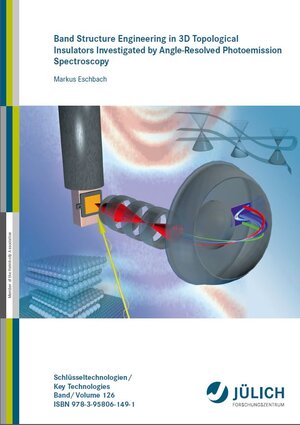
×
![Buchcover ISBN 9783958061491]()
Band Structure Engineering in 3D Topological Insulators Investigated by Angle-Resolved Photoemission Spectroscopy
von Markus EschbachThree-dimensional topological insulators (3D TIs) are a new state of quantum matter
and open up fascinating opportunities for novel spintronic devices due to their
unique electronic properties: the simultaneous presence of an insulating energy gap in
the bulk and conductive, spin-polarized electronic states at their surface. Unlike the
metallic surface states of ordinary (topologically trivial) materials, these (topologically
non-trivial) surface states are induced and protected by time reversal symmetry and
by a new bulk property, called topology. However, for the usability of TI materials in
spintronic devices one needs to find means to engineer their electronic band structure
such that the Fermi level falls into the band gap, since most of the 3D TI materials suffer
from significant bulk conductivity also at their surfaces.
In this thesis different approaches are presented to manipulate the Fermi level and
thereby engineer the electronic properties of thin films of typical 3D TI materials, such
as Bi2Se3, Bi2Te3, and Sb2Te3, which were grown by molecular beam epitaxy. Their
surface electronic structure is investigated using angle-resolved photoelectron spectroscopy.
Besides conventional approaches like surface or bulk doping, the successful realization
of a vertical topological p-n junction in epitaxial Sb2Te3/Bi2Te3/Si(111) heterostructures
is demonstrated for the first time. Besides the verification of the crystalline quality
of the bilayers and integrity of the interface, it is shown that it is possible to drive the
surface of Sb2Te3 from being p-type into n-type by varying the influence from the lower
Bi2Te3 layer, i. e. the built-in electrostatic potential caused by the depletion layer. The
experimental findings are supported by solving the Schrödinger and Poisson equations
self-consistently and thus simulating the band diagram throughout the heterostructure.
Further, a thorough investigation of the crystal structure as well as the rich electronic
(spin-) structure of the natural superlattice phase Bi1Te1 = (Bi2)1(Bi2Te3)2 is presented.
It is shown by density functional theory that Bi1Te1, contrary to the closely related,
prototypical strong 3D TI Bi2Te3, is a weak topological insulator with n0; (n1n2n3) =
0; (001). According to this, surfaces, which are perpendicular to the stacking direction,
i. e. parallel to the natural cleavage planes, are expected to be free of topological surface
states. Indeed, such surface is shown to exhibit surface states which in fact can easily
be confused with topological Dirac cones but do not possess a measurable helical spin
polarization which thus confirms the weak topological nature of Bi1Te1
and open up fascinating opportunities for novel spintronic devices due to their
unique electronic properties: the simultaneous presence of an insulating energy gap in
the bulk and conductive, spin-polarized electronic states at their surface. Unlike the
metallic surface states of ordinary (topologically trivial) materials, these (topologically
non-trivial) surface states are induced and protected by time reversal symmetry and
by a new bulk property, called topology. However, for the usability of TI materials in
spintronic devices one needs to find means to engineer their electronic band structure
such that the Fermi level falls into the band gap, since most of the 3D TI materials suffer
from significant bulk conductivity also at their surfaces.
In this thesis different approaches are presented to manipulate the Fermi level and
thereby engineer the electronic properties of thin films of typical 3D TI materials, such
as Bi2Se3, Bi2Te3, and Sb2Te3, which were grown by molecular beam epitaxy. Their
surface electronic structure is investigated using angle-resolved photoelectron spectroscopy.
Besides conventional approaches like surface or bulk doping, the successful realization
of a vertical topological p-n junction in epitaxial Sb2Te3/Bi2Te3/Si(111) heterostructures
is demonstrated for the first time. Besides the verification of the crystalline quality
of the bilayers and integrity of the interface, it is shown that it is possible to drive the
surface of Sb2Te3 from being p-type into n-type by varying the influence from the lower
Bi2Te3 layer, i. e. the built-in electrostatic potential caused by the depletion layer. The
experimental findings are supported by solving the Schrödinger and Poisson equations
self-consistently and thus simulating the band diagram throughout the heterostructure.
Further, a thorough investigation of the crystal structure as well as the rich electronic
(spin-) structure of the natural superlattice phase Bi1Te1 = (Bi2)1(Bi2Te3)2 is presented.
It is shown by density functional theory that Bi1Te1, contrary to the closely related,
prototypical strong 3D TI Bi2Te3, is a weak topological insulator with n0; (n1n2n3) =
0; (001). According to this, surfaces, which are perpendicular to the stacking direction,
i. e. parallel to the natural cleavage planes, are expected to be free of topological surface
states. Indeed, such surface is shown to exhibit surface states which in fact can easily
be confused with topological Dirac cones but do not possess a measurable helical spin
polarization which thus confirms the weak topological nature of Bi1Te1


